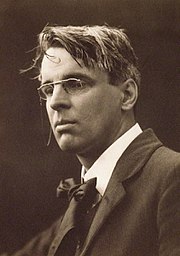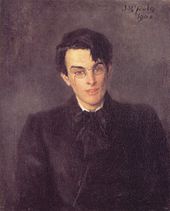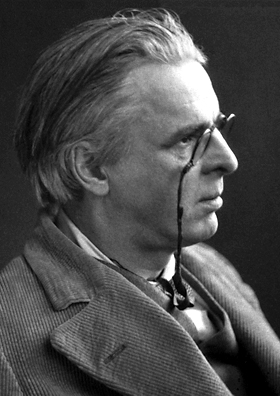دنیای زبان انگلیسی ( بهروزپور )
لغات و اصطلاح .داستان کوتاه . شعر.جوک .ضرب المثل.اشپزی.رمان. نمایشنامه.متن دوزبانهدنیای زبان انگلیسی ( بهروزپور )
لغات و اصطلاح .داستان کوتاه . شعر.جوک .ضرب المثل.اشپزی.رمان. نمایشنامه.متن دوزبانهWilliam Butler Yeats

William Butler Yeats (pronounced /ˈjeɪts/; 13 June 1865 – 28 January 1939) was an Irish poet and dramatist, and one of the foremost figures of 20th century literature. A pillar of both the Irish and British literary establishments, in his later years Yeats served as an Irish Senator for two terms. He was a driving force behind the Irish Literary Revival, and along with Lady Gregory, Edward Martyn, and others, founded the Abbey Theatre, serving as its chief during its early years. In 1923 he was awarded the Nobel Prize in Literature for what the Nobel Committee described as "inspired poetry, which in a highly artistic form gives expression to the spirit of a whole nation." He was the first Irishman so honored.[1] Yeats is generally considered one of the few writers who completed their greatest works after being awarded the Nobel Prize;[2] such works include The Tower (1928) and The Winding Stair and Other Poems (1929).
Yeats was born and educated in Dublin but spent his childhood in County Sligo. He studied poetry in his youth, and from an early age was fascinated by both Irish legends and the occult. Those topics feature in the first phase of his work, which lasted roughly until the turn of the 20th century. His earliest volume of verse was published in 1889, and those slow paced and lyrical poems display debts to Edmund Spenser and Percy Bysshe Shelley, as well as to the Pre-Raphaelite poets. From 1900, Yeats' poetry grew more physical and realistic. He largely renounced the transcendental beliefs of his youth, though he remained preoccupied with physical and spiritual masks, as well as with cyclical theories of life.
Young poet
The family returned to London in 1887. In 1890, Yeats co-founded the Rhymers' Club with Ernest Rhys,[17] a group of London based poets who met regularly in a Fleet Street tavern to recite their verse. The collective later became known as the "Tragic Generation"[18] and published two anthologies: first in 1892 and again in 1894. He collaborated with Edwin Ellis on the first complete edition of William Blake's works, in the process rediscovering a forgotten poem "Vala, or, the Four Zoas".[19] In a late essay on Shelley, Yeats wrote, "I have re-read Prometheus Unbound... and it seems to me to have an even more certain place than I had thought among the sacred books of the world."[20]

Yeats had a life-long interest in mysticism, spiritualism, occultism and astrology. He read extensively on the subjects throughout his life, became a member of the paranormal research organization "The Ghost Club" (in 1911) and was especially influenced by the writings of Emanuel Swedenborg.[21] As early as 1892, he wrote: "If I had not made magic my constant study I could not have written a single word of my Blake book, nor would The Countess Kathleen ever have come to exist. The mystical life is the centre of all that I do and all that I think and all that I write."[22] His mystical interests—also inspired by a study of Hinduism, under the Theosophist Mohini Chatterjee, and the occult—formed much of the basis of his late poetry. However, some critics have dismissed these influences as lacking in intellectual credibility. In particular, W. H. Auden criticized this aspect of Yeats' work as the "deplorable spectacle of a grown man occupied with the mumbo-jumbo of magic and the nonsense of India."[23]
His first significant poem was "The Isle of Statues", a fantasy work that took Edmund Spenser for its poetic model. The piece appeared in Dublin University Review, but has not since been republished. His first solo publication was the pamphlet Mosada: A Dramatic Poem (1886), which comprised a print run of 100 copies paid for by his father. This was followed by the collection The Wanderings of Oisin and Other Poems (1889), which arranged a series of verse that dated as far back as the mid-1880s. The long titular poem contains, in the words of his biographer R.F. Foster, "obscure Gaelic names, striking repetitions [and] an unremitting rhythm subtly varied as the poem proceeded through its three sections";[24]
We rode in sorrow, with strong hounds three,
Bran, Sgeolan, and Lomair,
On a morning misty and mild and fair.
The mist-drops hung on the fragrant trees,
And in the blossoms hung the bees.
We rode in sadness above Lough Lean,
For our best were dead on Gavra's green.
"The Wanderings of Oisin" is based on the lyrics of the Fenian Cycle of Irish mythology and displays the influence of both Sir Samuel Ferguson and the Pre-Raphaelite poets.[25] The poem took two years to complete and was one of the few works from this period that he did not disown in his maturity. Oisin introduces what was to become one of his most important themes: the appeal of the life of contemplation over the appeal of the life of action. Following the work, Yeats never again attempted another long poem. His other early poems, which are meditations on the themes of love or mystical and esoteric subjects, include Poems (1895), The Secret Rose (1897), and The Wind Among the Reeds (1899).
During 1885, Yeats was involved in the formation of the Dublin Hermetic Order. The society held its first meeting on 16 June, with Yeats acting as its chairman. The same year, the Dublin Theosophical lodge was opened in conjunction with Brahmin Mohini Chatterjee, who travelled from the Theosophical Society in London to lecture. Yeats attended his first séance the following year. He later became heavily involved with the Theosophical Society and with hermeticism, particularly with the eclectic Rosicrucianism of the Golden Dawn. During séances held from 1912, a spirit calling itself "Leo Africanus" apparently claimed to be Yeats' Daemon or anti-self, inspiring some of the speculations in Per Amica Silentia Lunae.[26] He was admitted into the Golden Dawn in March 1890 and took the magical motto Daemon est Deus inversus—translated as Devil is God inverted or A demon is a god reflected.[27] He was an active recruiter for the sect's Isis-Urania temple, and brought in his uncle George Pollexfen, Maud Gonne, and Florence Farr. Although he reserved a distaste for abstract and dogmatic religions founded around personality cults, he was attracted to the type of people he met at the Golden Dawn.[28] He was involved in the Order's power struggles, both with Farr and Macgregor Mathers, but was most notably involved when Mathers sent Aleister Crowley to repossess Golden Dawn paraphernalia during the "Battle of Blythe Road". After the Golden Dawn ceased and splintered into various offshoots, Yeats remained with the Stella Matutina until 1921
Style
Yeats is generally considered to be one of the twentieth century's key English language poets. He can be considered a Symbolist poet in that he used allusive imagery and symbolic structures throughout his career. Yeats chose words and assembled them so that in addition to a particular meaning they suggest other abstract thoughts that may seem more significant and resonant. His use of symbols[67] is usually something physical which is used both to be itself and to suggest other, perhaps immaterial, timeless qualities.[68]
Unlike other modernists who experimented with free verse, Yeats was a master of the traditional forms.[69] The impact of modernism on his work can be seen in the increasing abandonment of the more conventionally poetic diction of his early work in favour of the more austere language and more direct approach to his themes that increasingly characterises the poetry and plays of his middle period, comprising the volumes In the Seven Woods, Responsibilities and The Green Helmet.[70] His later poetry and plays are written in a more personal vein, and the works written in the last twenty years of his life include mention of his son and daughter,[71] as well as meditations on the experience of growing old.[72] In his poem, "The Circus Animals' Desertion", he describes the inspiration for these late works:
Now that my ladder's gone
I must lie down where all the ladders start
In the foul rag and bone shop of the heart.[73]
During 1929, he stayed at Thoor Ballylee (coordinates 53°06'11.4"N, 08°46'29.2"W), near Gort in County Galway (where Yeats had his summer home since 1919) for the last time. Much of the remainder of his life was lived outside of Ireland, although he did lease Riversdale house in the Dublin suburb of Rathfarnham in 1932. He wrote prolifically through his final years, and published poetry, plays, and prose. In 1938, he attended the Abbey for the final time to see the premier of his play Purgatory. His Autobiographies of William Butler Yeats was published that same year.[74]
While Yeats' early poetry drew heavily on Irish myth and folklore, his later work was engaged with more contemporary issues, and his style underwent a dramatic transformation. His work can be divided into three general periods. The early poems are lushly pre-Raphaelite in tone, self-consciously ornate, and, at times, according to unsympathetic critics, stilted. Yeats began by writing epic poems such as The Isle of Statues and The Wanderings of Oisin. After Oisin, he never attempted another long poem.[75] His other early poems are lyrics on the themes of love or mystical and esoteric subjects. Yeats' middle period saw him abandon the pre-Raphaelite character of his early work[76] and attempt to turn himself into a Landor-style social ironist.[77]
Critics who admire his middle work might characterize it as supple and muscular in its rhythms and sometimes harshly modernist, while others find these poems barren and weak in imaginative power. Yeats' later work found new imaginative inspiration in the mystical system he began to work out for himself under the influence of spiritualism. In many ways, this poetry is a return to the vision of his earlier work. The opposition between the worldly-minded man of the sword and the spiritually-minded man of God, the theme of The Wanderings of Oisin, is reproduced in A Dialogue Between Self and Soul.[78]
Some critics claim that Yeats spanned the transition from the nineteenth century into twentieth-century modernism in poetry much as Pablo Picasso did in painting while others question whether late Yeats really has much in common with modernists of the Ezra Pound and T. S. Eliot variety.[79] Modernists read the well-known poem "The Second Coming" as a dirge for the decline of European civilisation in the mode of Eliot, but later critics have pointed out that this poem is an expression of Yeats' apocalyptic mystical theories, and thus the expression of a mind shaped by the 1890s. His most important collections of poetry started with The Green Helmet (1910) and Responsibilities (1914). In imagery, Yeats' poetry became sparer, more powerful as he grew older. The Tower (1928), The Winding Stairs (1929), and New Poems (1938) contained some of the most potent images in twentieth-century poetry.
Yeats' mystical inclinations, informed by Hindu Theosophical beliefs and the occult, formed much of the basis of his late poetry,[80] which some critics have judged as lacking in intellectual credibility. The metaphysics of Yeats' late works must be read in relation to his system of esoteric fundamentalities in A Vision (1925).[81]
His 1920 poem, "The Second Coming" contains some of literature's most potent images of the twentieth century.
Things fall apart; the centre cannot hold;
Mere anarchy is loosed upon the world,
The blood-dimmed tide is loosed, and everywhere
The ceremony of innocence is drowned.
The best lack all conviction, while the worst
Are full of passionate intensity.[82]
According to some interpretations 'the best' referred to the traditional ruling classes of Europe who were unable to protect the traditional culture of Europe from materialistic mass movements. The concluding lines refer to Yeats' belief that history was cyclic, and that his age represented the end of the cycle that began with the rise of Christianity.
And what rough beast, its hour come round at last,
Slouches towards Bethlehem to be born?
